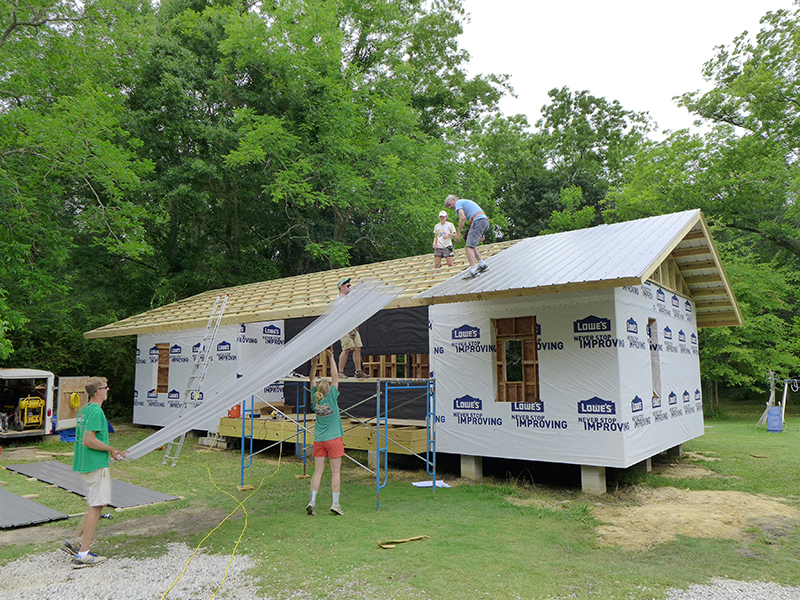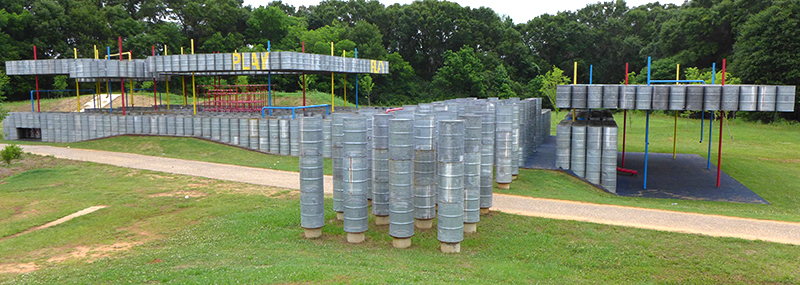 Architecture students on a higher mission to improve the quality of life in Hale County
Architecture students on a higher mission to improve the quality of life in Hale County
Story and photos by David Haynes
Three-quarters of a century ago James Agee and Walker Evans first brought Hale County, Alabama, into the national consciousness with their book, Let Us Now Praise Famous Men, which documented the hardscrabble life of poor tenant farmers during the depression-era 1930s. Today that same Black Belt region is making headlines for innovative, creative and practical architecture, thanks to the efforts of Auburn University’s Rural Studio.
Based in the tiny town of Newbern, a few miles south of Greensboro on Highway 61, Rural Studio has for the past 20 years been a place where architecture students not only design affordable and useful additions to the community, but also where the same students use their own sweat and labor to carry their visions to the ultimate completion by actually building the structures they’ve designed.
Rural Studio was founded in 1993 by professors Samuel Mockbee and D.K. Ruth.
Mockbee, who once complained that too many architects had become the “lapdogs of the rich,” believed his architecture students should be ingrained with a higher moral mission to serve the needs of those with more limited means.
And for the past 20 years Rural Studio has done just that. An impressive list of community-oriented projects designed and built by Rural Studio students includes Newbern’s town hall and fire station, as well as numerous other civic projects in the nearby county seat in Greensboro, where projects ranging from a sports park, Boys and Girls Club and even a skateboard park have been conceived and executed by Rural Studio’s students. All Rural Studio projects are situated within 25 miles of its home base in Newbern, including several ambitious projects like the Rural Heritage Center in nearby Thomaston and a 110-foot-tall bird watching tower near Marion at Perry Lakes Park.
In its two decades of operation, Rural Studio has been recognized with numerous awards from the American and even international architectural communities. Its work here is known around the world and it has become a pilgrimage destination for professionals in the field.
Rural Studio, its mission and accomplishments, have been the subject of several books, including the most recent – Rural Studio at Twenty, Designing and Building in Hale County, Alabama – published by the Princeton Architectural Press in 2014.

A two-story house on Highway 61 just south of the town center in Newbern serves as Rural Studio’s headquarters. Surrounding the house are various mock-ups of projects both completed and under construction, including a huge greenhouse project that will become the centerpiece of the studio’s self-sustaining agriculture project in coming years.
When I visited recently, Natalie Butts, manager of the studio’s 20th anniversary, gave me a short tour of projects in Newbern that were both completed – like the fire station and town hall – and those under construction, such as the town’s new library. The day of my visit students Will Gregory and Ashley Clark were installing new wooden trim on the facade of an old bank building that is being renovated into the Newbern Town Library.
Later she sent me to visit the sites of two “$20K” houses under construction by other student teams just south of town. These houses are an effort to help residents with limited means to have attractive, practical and affordable housing with a price cap of $20,000 as an alternative to the trailer park as residence.
Explaining the concept, Rural Studio Director Andrew Freear wrote in the 20th anniversary book: “We looked at the omnipresent American trailer park, where homes, counterproductively, depreciate each year they are occupied. We wanted to create an attractive small house that would appreciate in value while accommodating residents who are unable to qualify for credit. Our goal was to design a market-rate model house that could be built by a contractor for $20,000.”
At one of the $20K home sites, Samuel Maddox and Caleb Gardner were pulling wooden concrete forms from the interior “tornado room” for a house 10 miles from Newbern. At another house site closer to town, students Sean Flaharty, Chloe Schultz, Jeff Bak and Mackenzie Staggs were working with Freear to put a metal roof on another of the $20K houses.
From there I visited the Lions Park complex in nearby Greensboro, the site of several completed projects as well as the Scout Hut, which is still under construction. One impressive sight was a children’s playground made entirely of colorfully painted, surplus 55-gallon oil barrels to form canyon-like passageways and mazes that would be a delight for any child to explore. A few hundred feet from the playground is the skateboard park with its waves of concrete interspaced with walkways and shaded sitting areas.
While there I ran into a group of architecture students from another school who’d come to see some of what Rural Studio students had built.
Around the corner from the skate park was the Scout Hut, which was still under construction. Just down the street is the huge open gymnasium for the Greensboro Boys and Girls Club. Natalie explained that often students who are involved with projects that are not completed before they graduate will return to work as volunteers to help with finishing their projects.

Before leaving the area I stopped outside Marion to revisit the Perry Lakes Park Birding Tower. This was a forestry service fire tower located near Demopolis that had been taken out of service. Rural Studio students dismantled the 110-foot-high tower, hauled it to the Perry Lakes site in a cypress swamp near the Cahaba River, then reassembled it minus the enclosed cab at the top. As impressive as the view from the tower is, the boardwalk and triangular-shaped covered footbridge through the cypress trees to reach it are certainly a treat as well.
Almost 80 years ago Agee’s prose and Evans’ photographs painted a bleak picture of daylight-to-dark work and squalid living conditions in this part of west Alabama. Today, thanks in large part to efforts by Rural Studio, its mission and more than 150 projects, the quality of life here has improved greatly in the past two decades and will likely continue for decades to come.
For more on Rural Studio, visit www.ruralstudio.org.




